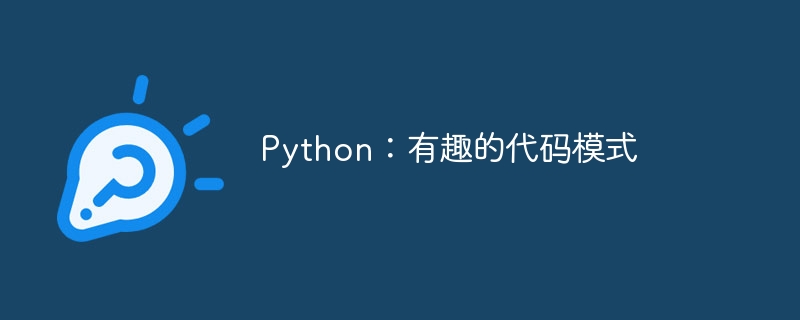Python:有趣的代码模式
来源:dev.to
时间:2024-09-09 10:37:03 272浏览 收藏
今日不肯埋头,明日何以抬头!每日一句努力自己的话哈哈~哈喽,今天我将给大家带来一篇《Python:有趣的代码模式》,主要内容是讲解等等,感兴趣的朋友可以收藏或者有更好的建议在评论提出,我都会认真看的!大家一起进步,一起学习!

我主要使用 python 工作,几乎每天都会检查代码。在我们的代码库中,格式化和 linting 由 ci 作业使用 black 和 mypy 处理。所以,我们只关注改变。
在团队中工作时,您已经知道某个团队成员会编写什么样的代码。当新人加入团队时,代码审查会变得有趣。我说有趣,是因为每个人都有一些他们不自觉地使用的编码风格;无论好坏!就像我有一些,
- 设置optionaltype的值。 通常这些变量是签名的一部分
# i used (long back) to do
def func(a: int, b: optional[list] = none, c: optional[dict] = none):
if b is none:
b = []
if c is none:
c = {}
# instead i do
def func(a: int, b: optional[list] = none, c: optional[dict] = none):
b = b or []
c = c or {}
- 使用 dict 处理简单的 if..elif..else (最多 3-4 个)语句
这是一个简单的用例,您可以根据某个值返回字符串或调用函数
注意:从 3.10 开始你应该使用 match 而不是这个。
而不是做,
def get_number_of_wheels(vehicle: str):
if vehicle == "car":
wheels = 2
elif vehicle == "bus":
wheels = 6
elif vehicle == "bicycle":
wheels = 2
else:
raise ...
# i prefer doing,
def get_number_of_wheels(vehicle: str):
return {
"car": 2,
"bus": 6,
"bicycle": 2
}[vehicle] # raise is now keyerror
上面是几个例子,审阅我的代码的人将会有更多的例子。
最近,一位新开发人员加入了我的团队,我注意到了一种我喜欢的模式,但我要求将其更改为简单的 if..else 情况。我会先向您展示模式,然后给出我要求更改的理由。
代码是一个装饰器,它对参数进行一些操作。让我们编写一个简单的(无用的)装饰器,它将打印调用函数/方法的参数和 kwargs 的数量。
def counter(is_cls_method: bool = false):
""" print number of args & kwargs for func/method """
def outer(f):
def inner(*args, **kwargs):
args_cnt = len(args)
kwargs_cnt = len(kwargs)
print(f"{f.__name__} called with {args_cnt=} & {kwargs_cnt=}")
return f(*args, **kwargs)
return inner
return outer
@counter()
def test1(a, b, c):
pass
class a:
@counter(is_cls_method=true)
def test1(self, a, b, c):
pass
print("function")
test1(1, 2, c=3)
test1(a=1, b=2, c=3)
print("method")
a = a()
a.test1(1, 2, 3)
a.test1(1, b=2, c=3)
运行此代码时,您应该看到
function test1 called with args_cnt=2 & kwargs_cnt=1 test1 called with args_cnt=0 & kwargs_cnt=3 method test1 called with args_cnt=4 & kwargs_cnt=0 test1 called with args_cnt=2 & kwargs_cnt=2
它工作正常,但对于方法来说,它也在计算自我。所以让我们解决这个问题!
def counter(is_cls_method: bool = false):
def outer(f):
def inner(*args, **kwargs):
args_cnt = len(args)
if is_cls_method: # check added
args_cnt -= 1 # reduced count by 1
kwargs_cnt = len(kwargs)
print(f"{f.__name__} called with {args_cnt=} & {kwargs_cnt=}")
return f(*args, **kwargs)
return inner
return outer
这是一个简单的 if 子句,但新开发人员做了其他一些有趣的布尔值使用。
我只显示更改后的代码...
args_cnt = len(args[is_cls_method:])
解决方案比使用 if 好得多,因为 python 中的 bool 只是 int。原始代码有点长,注意到这个小变化并不明显,基本 python 用户使用的代码库也是如此。而且,如果您必须猜测一条线在做什么,我认为您应该进行更改以使其显而易见。
你对此有何看法,你使用布尔值作为索引吗?
你还有类似的python模式吗?
理论要掌握,实操不能落!以上关于《Python:有趣的代码模式》的详细介绍,大家都掌握了吧!如果想要继续提升自己的能力,那么就来关注golang学习网公众号吧!
-
501 收藏
-
501 收藏
-
501 收藏
-
501 收藏
-
501 收藏
-
242 收藏
-
383 收藏
-
358 收藏
-
165 收藏
-
449 收藏
-
216 收藏
-
325 收藏
-
300 收藏
-
337 收藏
-
385 收藏
-
165 收藏
-
254 收藏
-

- 前端进阶之JavaScript设计模式
- 设计模式是开发人员在软件开发过程中面临一般问题时的解决方案,代表了最佳的实践。本课程的主打内容包括JS常见设计模式以及具体应用场景,打造一站式知识长龙服务,适合有JS基础的同学学习。
- 立即学习 543次学习
-

- GO语言核心编程课程
- 本课程采用真实案例,全面具体可落地,从理论到实践,一步一步将GO核心编程技术、编程思想、底层实现融会贯通,使学习者贴近时代脉搏,做IT互联网时代的弄潮儿。
- 立即学习 516次学习
-

- 简单聊聊mysql8与网络通信
- 如有问题加微信:Le-studyg;在课程中,我们将首先介绍MySQL8的新特性,包括性能优化、安全增强、新数据类型等,帮助学生快速熟悉MySQL8的最新功能。接着,我们将深入解析MySQL的网络通信机制,包括协议、连接管理、数据传输等,让
- 立即学习 500次学习
-

- JavaScript正则表达式基础与实战
- 在任何一门编程语言中,正则表达式,都是一项重要的知识,它提供了高效的字符串匹配与捕获机制,可以极大的简化程序设计。
- 立即学习 487次学习
-

- 从零制作响应式网站—Grid布局
- 本系列教程将展示从零制作一个假想的网络科技公司官网,分为导航,轮播,关于我们,成功案例,服务流程,团队介绍,数据部分,公司动态,底部信息等内容区块。网站整体采用CSSGrid布局,支持响应式,有流畅过渡和展现动画。
- 立即学习 485次学习
